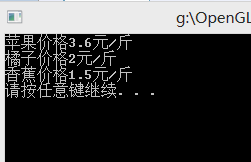hash_set和hash_map
1.hash_set集合容器
hash_set利用链式哈希表,进行数据的插入、删除和搜索。与set容器相同,不允许插入重复键值的元素。SGIC++哈希表是一个链式的结构,由表头和一系列单链组成。表头是一个数组式的线性表,用vector向量泛化出来。每个表头节点,称为桶(bucket),是一个指针域,指向链入的元素数据。表头的长度为向量容器的元素个数。
哈希表中数据的遍历,迭代器从0号桶、1号桶、2号桶,······,逐一遍历每个桶中的所有元素数据。
哈希表的数据检索,是通过哈希函数,计算出数据所存放的哈希地址,即算出数据在哪个桶的单链中,然后对单链中的每个数据进行比较,检索出所要的数据。因此,每个桶中的数据越少,比较的次数就越少,检索的效率越高。
实际应用中,具体将多少数据存入哈希表中是无法预先确定的,可以设定初始的哈希表长,随着数据量的增长,动态调整表长的大小。表长过长,会造成表头空间的浪费;表长过短,会造成每个桶下面链的元素过多,导致检索效率不高。为了使每个桶中的元素尽可能地少,SGI C++使用质数作为表长,并且使用表长作为求余运算的模,构造哈希函数。SGI C++ STL中,用作表长的的质数预先用一个28个元素的数组给出,这28个质数足够覆盖32bit的任意表长范围。
1.1创建hash_set对象
主要有以下几种方式。
(1) hash_set()
创建一个空的hash集合容器。哈希表长取默认值193,哈希函数对象为默认的hasn<Value>,键值比较实用默认的函数对象equal_to<Value>,内存分配器也取默认值。
hash_set<int> hs;
(2) hash_set(size_type n)
从质数列表中找出第一个大于等于n的质数作为表长,创建一个空的哈希集合容器,哈希函数对象、键值比较函数对象和内存分配器也取默认值。
hash_set<int> hs(300);//创建一个表长为389的哈希集合容器对象
(3) hash_set(size_type n,consthasher&h)
用大于等于n的质数作为表长,哈希函数对象为h,创建哈希集合容器对象。
structmyHash{
size_t operator()(int x)const{return x+2;}
};
hash_set<int,myHash> hs(300,myHash());
(4) hash_set(size_type n,consthasher&h,const key_equal&k)
用大于等于n的质数作为表长,哈希函数对象为h,键值比较函数对象k,创建哈希集合容器对象。
structstrEqual{
bool operator()(const char *s1,const char*s2)const
{
return strcmp(s1,s2)==0;
}
};
hash_set<char*,hash<char*>,strEqual>hash(300,hash<char*>(),strEqual());
(5) hash_set(const hash_set&)
拷贝构造函数。
hash_set<int> hs1;
hash_set<int> hs2(hs1);
1.2元素的插入
使用insert函数进行插入,哈希集合容器不允许插入重复的元素键值,否则插入失败。
hash_set<int> hs;
hs.insert(31);
hs.insert(23);
hs.insert(193);
1.3元素的删除
利用erase、clear函数可以删除某个迭代器位置上的元素、等于某个键值的元素、迭代器区间元素和容器上的所有元素。
1.4元素的遍历
利用迭代器实现哈希集合容器内元素的遍历。
#include <iostream>
#include <hash_set>
using stdext::hash_set;
using namespace std;
int main()
{
hash_set<int> hs;
hs.insert(1);
hs.insert(23);
hs.insert(193);
hash_set<int>::iterator begin,end;
end=hs.end();
for(begin=hs.begin();begin!=end;begin++)
{
cout<<*begin<<endl;
}
system("pause");
return 0;
}
注意:在vs2008中使用hash_set需要用usingstdext::hash_set;因为hash_set是vs2008的一个扩展,并没有在标准C++库中。
1.5元素的搜素
利用find函数可以实现元素的搜索,返回搜索到的元素的位置。
#include <iostream>
#include <hash_set>
using stdext::hash_set;
using namespace std;
struct strEqual{
bool operator()(const char* s1,const char* s2)const{
return strcmp(s1,s2)==0;
}
};
int main()
{
hash_set<char *,hash_set<char *>,strEqual> hs;
hs.insert("apple");
hs.insert("pear");
hs.insert("banana");
hs.insert("orange");
//搜索元素banana
hash_set<char*,hash_set<char*>,strEqual>::iterator i;
i=hs.find("banana");
cout<<"查找结果:"<<*i<<endl;
system("pause");
return 0;
}
1.6其他常用函数
hash_set容器还有其他常用函数,empty、size、bucket_count、swap、resize和equal_range等函数可以获得容器的统计信息。
#include <iostream>
#include <hash_set>
using stdext::hash_set;
using namespace std;
int main()
{
hash_set<int> hs;
hs.insert(10);
hs.insert(30);
hs.insert(100);
hs.insert(23);
cout<<hs.empty()<<endl;//是否为空
cout<<hs.size()<<endl;//统计元素个数
cout<<hs.bucket_count()<<endl;//统计表长
system("pause");
return 0;
}
2.hash_map哈希映射容器
hash_map容器与map容器类似,都是将记录型的元素根据键值的大小将其插入容器,但是,hash_map使用的数据结构是哈希表,map使用的数据结构是红黑树。hash_map检索出来的元素是无序的,而map用迭代器遍历出来的元素是排序的,而且还提供了反向迭代器。
2.1创建hash_map对象
主要有以下几种方式。
(1) hash_map()
hash_map<int,char*> hm;
(2) hash_map(size_type n)
hash_map<int,char*> hm(300);
(3) hash_map(size_type n,consthasher& h)
struct myhash{
size_t operator()(int x)const{return x+2;}
};
hash_map<int,char*,myhash> hm(300,myhash());
(4) hash_map(size_type n,consthasher& h,const key_equal& k)
structstrequal{
bool operator()(const char* s1,const char*s2)const
{
return strcmp(s1,s2)==0;
}
};
hash_map<char*,int,hash<char*>,strequal>hm(300,hash<char*>(),strequal());
(5) hash_map(const hash_map&)
拷贝构造函数。
hash_map<int,char*> hm1;
hash_map<int,char*> hm2(hm1);
2.2元素的插入
利用insert函数可以将键值不重复的元素数据插入到容器的哈希表中。
#include<iostream>
#include<hash_map>
using stdext::hash_map;
using namespace std;
int main()
{
hash_map<const char*,float> hm;
hm["apple"]=3.6f;
hm["orange"]=2.0f;
hm["banana"]=1.5f;
cout<<"苹果价格"<<hm["apple"]<<"元/斤"<<endl;
cout<<"橘子价格"<<hm["orange"]<<"元/斤"<<endl;
cout<<"香蕉价格"<<hm["banana"]<<"元/斤"<<endl;
system("pause");
return 0;
}
注:在vs2008中使用hash_map需要用usingstdext::hash_map;因为hash_map是vs2008的一个扩展,并没有在标准C++库中。
2.3元素的删除
利用erase函数和clear函数可以实现删除某个迭代器位置上的元素、等于某个键值的元素、迭代器区间上的元素和容器的所有元素。
2.4元素的遍历
利用迭代器可以实现元素的遍历。
#include<iostream>
#include<hash_map>
using stdext::hash_map;
using namespace std;
template<class Key, class NameType, class YearType, class AddrType>
struct StudentRecord_tag{ //学生记录结构体
struct StudentInfo_tag{ //学生信息结构体
NameType name;
YearType year;
AddrType addr;
};
//提供类型信息
typedef Key IdType;
typedef StudentInfo_tag StudentInfo;
//数据成员
IdType id; //学号,键值
StudentInfo sf; //学生信息,作映照数据
};
int main(void){
//using namespace std;
typedef StudentRecord_tag<int, char*, int, char*> StudentRecord;
//学生数据
StudentRecord srArray[] = { //3笔学生记录
{ 192, "李强", 21, "北京" },
{ 193, "王文", 29, "上海" },
{ 191, "张三", 38, "深圳" }
};
//创建hash_map容器对象hm,管理学生记录
hash_map<StudentRecord::IdType, StudentRecord::StudentInfo> hm;
//装入3笔学生记录
for(int j=0; j<3; j++)
hm[srArray[j].id]=srArray[j].sf;
//迭代器遍历元素
hash_map<StudentRecord::IdType, StudentRecord::StudentInfo>::iterator i,iend;
iend=hm.end();
cout << "学号 " << "姓名 " << "年龄 " << "地址 " << endl; //Tab键分隔
for(i=hm.begin(); i!=iend; i++)
cout << (*i).first << ' '
<< (*i).second.name << ' '
<< (*i).second.year << ' '
<< (*i).second.addr << ' '
<< endl;
system("pause");
return 0;
}
2.5元素的搜索
利用find函数可以搜索扫某个元素的位置,若不存在,则返回一个结束元素的位置。
// hash_map<StudentRecord::IdType,StudentRecord::StudentInfo>::iterator i;
i=hm.find(193);
2.6其他常用函数
与hash_set容器一样,hash_map提供了empty、size、bucket_count、swap、resize和equal_range等函数可以取得容器的统计数据。
#include<iostream>
#include<hash_map>
using stdext::hash_map;
using namespace std;
int main(void){
//using namespace std;
hash_map<int, char> hm;
typedef pair<hash_map<int, char>::iterator, bool> ReturnPair;
typedef pair<int, char> InsertPair;
ReturnPair p;
InsertPair p1(10, 'a'), p2(20, 'c'), p3(80, 'e');
//插入p1
p=hm.insert(p1);
if(!p.second) cout << "插入p1失败\n";
//插入p2
p=hm.insert(p2);
if(!p.second) cout << "插入p2失败\n";
//插入p3
p=hm.insert(p3);
if(!p.second) cout << "插入p3失败\n";
//打印统计数据
cout << hm.empty() << endl; //打印是否为空(false为0)
cout << hm.size() << endl; //打印元素个数(3)
cout << hm.bucket_count() << endl; //打印表长(193)
system("pause");
return 0;
}




